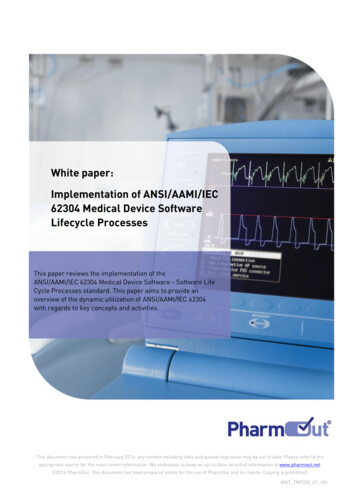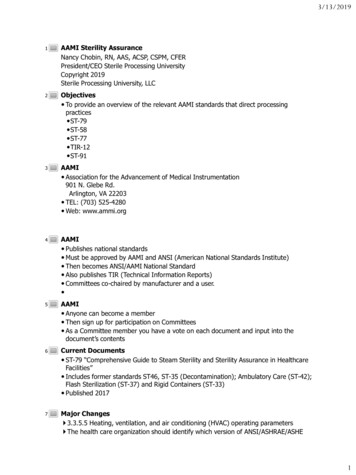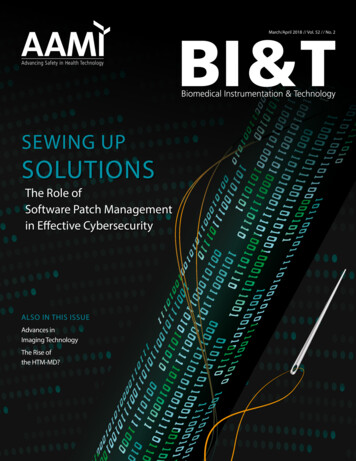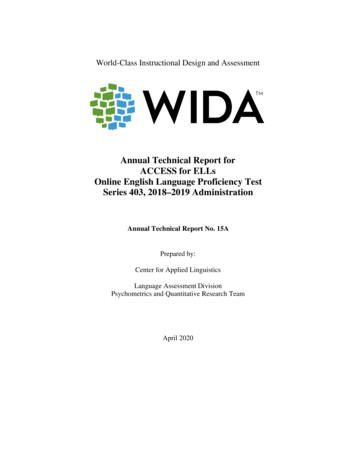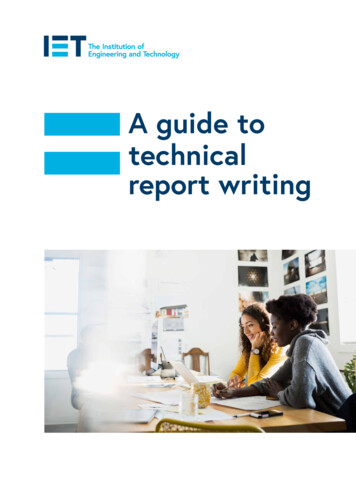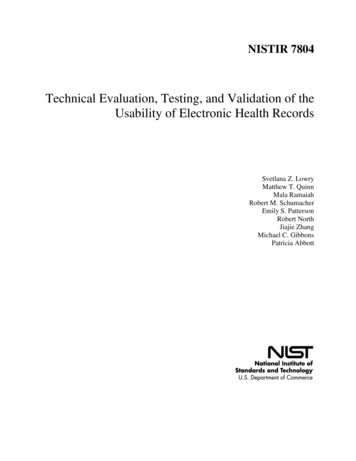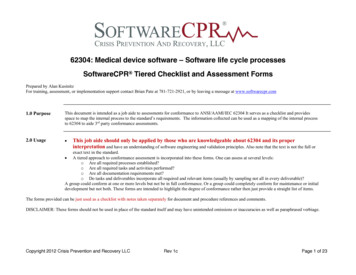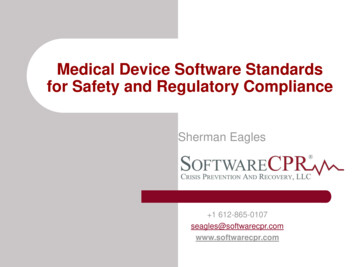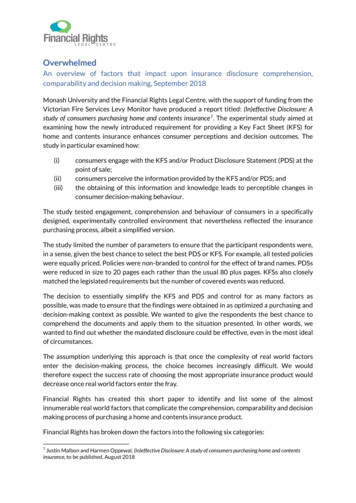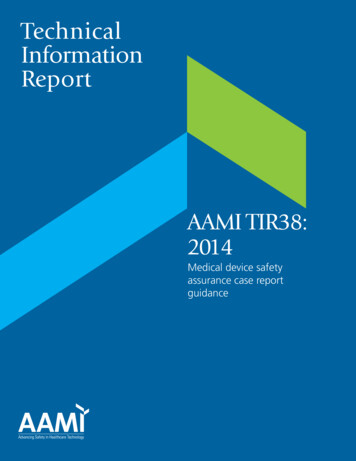
Transcription
TechnicalInformationReportAAMI TIR38:2014Medical device safetyassurance case reportguidance
AAMISingle user license. Copying, networking, and distribution prohibited.
AAMI Technical Information ReportAAMI TIR38:2014Medical device safety assurancecase report guidanceApproved 23 December 2014 byAssociation for the Advancement of Medical InstrumentationAbstract:Provides guidance on how to complete an Assurance Case Report in order to complywith the new additional FDA pre-market requirements for infusion pumps. Includes adetailed but strictly hypothetical example from the medical device domain.Keywords:safety claim, risk management, infusion pumpsAAMISingle user license. Copying, networking, and distribution prohibited.
AAMI Technical Information ReportA technical information report (TIR) is a publication of the Association for the Advancement of MedicalInstrumentation (AAMI) Standards Board that addresses a particular aspect of medical technology.Although the material presented in a TIR may need further evaluation by experts, releasing the information isvaluable because the industry and the professions have an immediate need for it.A TIR differs markedly from a standard or recommended practice, and readers should understand the differencesbetween these documents.Standards and recommended practices are subject to a formal process of committee approval, public review, andresolution of all comments. This process of consensus is supervised by the AAMI Standards Board and, in the caseof American National Standards, by the American National Standards Institute.A TIR is not subject to the same formal approval process as a standard. However, a TIR is approved for distributionby a technical committee and the AAMI Standards Board.Another difference is that although both standards and TIRs are periodically reviewed, a standard must be acted on—reaffirmed, revised, or withdrawn—and the action formally approved usually every 5 years but at least every 10 years.For a TIR, AAMI consults with a technical committee about five years after the publication date (and periodicallythereafter) for guidance on whether the document is still useful—that is, to check that the information is relevant or ofhistorical value. If the information is not useful, the TIR is removed from circulation.A TIR may be developed because it is more responsive to underlying safety or performance issues than a standardor recommended practice, or because achieving consensus is extremely difficult or unlikely. Unlike a standard, a TIRpermits the inclusion of differing viewpoints on technical issues.CAUTION NOTICE: This AAMI TIR may be revised or withdrawn at any time. Because it addresses a rapidlyevolving field of technology, readers are cautioned to ensure that they have also considered information that may bemore recent than this document.All standards, recommended practices, technical information reports, and other types of technical documentsdeveloped by AAMI are voluntary, and their application is solely within the discretion and professional judgment of theuser of the document. Occasionally, voluntary technical documents are adopted by government regulatory agenciesor procurement authorities, in which case the adopting agency is responsible for enforcement of its rules andregulations.Comments on this technical information report are invited and should be sent to AAMI, Attn: Standards Department,4301 N. Fairfax Dr., Suite 301, Arlington, VA 22203-1633.Published byAssociation for the Advancement of Medical Instrumentation4301 N. Fairfax Dr., Ste. 301Arlington, VA 22203-1633www.aami.org 2015 by the Association for the Advancement of Medical InstrumentationAll Rights ReservedPublication, reproduction, photocopying, storage, or transmission, electronically or otherwise, of all or any part of thisdocument without the prior written permission of the Association for the Advancement of Medical Instrumentation isstrictly prohibited by law. It is illegal under federal law (17 U.S.C. § 101, et seq.) to make copies of all or any part ofthis document (whether internally or externally) without the prior written permission of the Association for theAdvancement of Medical Instrumentation. Violators risk legal action, including civil and criminal penalties, anddamages of 100,000 per offense. For permission regarding the use of all or any part of this document, contact AAMIat 4301 N. Fairfax Dr., Suite 301, Arlington, VA 22203-1633. Phone: (703) 525-4890; Fax: (703) 525-1067.Printed in the United States of AmericaISBN 1-57020-577-9AAMISingle user license. Copying, networking, and distribution prohibited.
ContentsPageGlossary of equivalent standards . ivCommittee representation . vForeword . viIntroduction . vii1Purpose . 12Scope . 13Relationship to other standards . 14Terms and definitions . 25Regulatory context . 36Safety case model for a generic medical device . 36.1Model objective . 36.2Safety case introduction . 36.3Proposed model — Safety case elements. 46.4Proposed model – Example drug delivery safety case . 77Generation of system and sub-system hazards . 148Confidence case. 159Challenge . 1710 Common mistakes to avoid . 1811 Developing a safety case for an existing device . 1911.1Developing arguments . 1911.2Developing evidence . 2011.3Kelly’s Six Step Process. 2112 Safety cases and risk management . 2212.1Similarities between assurance case development and risk management . 2212.2Gaps between ANSI/AAMI/ISO 14971 and safety cases . 2213 Lifecycle management . 2214 Maintaining the safety case. 2315 Styles of safety case notation . 2315.1Graphical notations . 2315.2Structures . 24Annex A (informative) Assurance cases and evidence of substantial equivalence . 26Annex B (informative) Safety case model examples . 27Annex C (informative) AdvaMed Infusion Pump Assurance Case (IPAC) Template . 31Annex D (informative) Tool selection considerations . 50Annex E (informative) Developing a safety case for an existing product. 51Annex F (informative) Lessons learned regarding safety cases . 53Bibliography . 55AAMISingle user license. Copying, networking, and distribution prohibited.
Glossary of equivalent standardsInternational Standards adopted in the United States may include normative references to other InternationalStandards. AAMI maintains a current list of each International Standard that has been adopted by AAMI (and ANSI).Available on the AAMI website at the address below, this list gives the corresponding U.S. designation and level ofequivalency to the International ngle user license. Copying, networking, and distribution prohibited.iv 2015 Association for the Advancement of Medical Instrumentation AAMI TIR38:2014
Committee representationAssociation for the Advancement of Medical InstrumentationInfusion Device CommitteeThis AAMI Technical Information Report (TIR) was developed and approved by the AAMI Infusion Device Committee.At the time this document was published, the AAMI Infusion Device Committee had the following members:Cochairs:Pat Baird, MBA, MS, Baxter Healthcare CorporationRyan McGowan, OSB, FDA/CDRHMembers:Keith B. Anderson, BSEE, Smiths MedicalAnthony R. Ball, Toxikon CorporationSteve J. Bernard, Nestle HealthCare Nutrition IncBrad Bonnette, ECRI InstituteEric L. Brennan, MS MPA, Valex Healthcare IncRobert D. Butterfield, CareFusionGeoffrey Blake Collins, MBA CBET, Christiana Care Health ServicesTodd Cooper, Center for Medical InteroperabilitySherman Eagles, SoftwareCPRGary Freitag, Greatbatch IncGeorge W. Gray, Ivenix IncRobert Rabeh Hijazi, MS MHA CBET, St Louis VA Medical Center - John Cochran DivisionDouglas JohnsonLee Leichter, P/L BiomedicalAlan Lipschultz, CCE, PE, CSP, HealthCare Technology Consulting LLCYuliya Matlin, MS, Hospira Worldwide IncJames R Milostan, Medical Specialties Distributors LLCRavi Narayanan, Value Plastics IncShawn O'Connell, MS, RN, B Braun of America IncAndrew M. Rich, CBET, Childrens Hospital of PhiladelphiaPhilip J Schneider, University of Arizona/LibraryNathaniel M. Sims, MD, Massachusetts General HospitalJames Tiefenthal, Battelle Medical ProductsRamakrishna Venugopalan, Johnson & JohnsonAlternates:Michael John Brady, PhD, Toxikon CorporationMichael Brown, B Braun of America IncWilliam K. Day, Hospira Worldwide IncLane Desborough, Medtronic Inc WHQ CampusChristine A. Frysz, PhD, Greatbatch IncEric R. Johnson, Nestle HealthCare Nutrition IncPaul L. Jones, CDP CSQE, FDA/CDRHJohn J. Sokolowski, Ivenix IncJoyce Young-Stewart, RN, Baxter Healthcare CorporationNOTE—Participation by federal agency representatives in the development of this document does not constituteendorsement by the federal government or any of its agencies.AAMISingle user license. Copying, networking, and distribution prohibited. 2015 Association for the Advancement of Medical Instrumentation AAMI TIR38:2014v
ForewordA challenge with ANSI/AAMI/ISO 14971 is that it does not require a formal, organized summary of why the device issafe for its intended use. While ANSI/AAMI/ISO 14971 requires a series of discrete analyses and reports, there is nooverview document that provides a roadmap to product risk. Although ANSI/AAMI/ISO 14971 requires a riskmanagement report, this report is at a very high level. The requirements of ANSI/AAMI/ISO 14971 ensure that anOverall Residual Risk Evaluation has taken place, and that a risk management report ensures that:a) The risk management plan has been appropriately implemented;b) Appropriate methods are in place to obtain relevant production and post-production information.Thus, a risk management file created according to these tenets would not actually summarize the findings andactions from risk management activities; it would not tell the story of safety.A reviewer is often faced with thousands of pages of design documentation, with no overall summary as to why thedesigners believe the product is safe. Additionally, if the reviewer is interested in a particular issue, there is noroadmap to finding that issue within the design documentation. The set of risk management documents may form ajigsaw puzzle of discrete elements, with no picture of how they fit together.The Medical Device Safety Assurance Case outlined in this technical information report (TIR) provides acomprehensive and organized summary of product risk along with the evidence-based arguments that support theclaims that the hazards that may arise from risk has either been eliminated or mitigated to the extent that the productis safe for its intended use.An assurance case includes a top-level claim for a property of a system or product (or set of claims),systematic argumentation regarding this claim, and the evidence and explicit assumptions that underlie thisargumentation. Arguing through multiple levels of subordinate claims, this structured argumentationconnects the top-level claim to the evidence and assumptions. [ISO/IEC 15026-2:2011]An assurance case is a systematic, structured methodology for supporting a stated claim. The claim may be relatedto safety, reliability, maintainability, security, etc. A safety assurance case is an assurance case with a top-level claimof safety.This TIR provides information useful to creating and maintaining safety assurance cases for medical devices. It doesthis in the context of ANSI/AAMI/ISO 14971 and ISO/IEC 15026-2. There is additional discussion about therelationship between risk management and safety assurance cases in section 7.While the examples used in this TIR are based on infusion pumps, the same principles apply to developing safetyassurance cases for any medical device.Suggestions for improving this recommended practice are invited. Comments and suggested revisions should be sentto Technical Programs, AAMI, 4301 N. Fairfax Drive, Suite 301, Arlington, VA 22203-1633.NOTE—This foreword does not contain provisions of the AAMI TIR38, Medical device safety assurance case guidance(AAMI TIR38:2014), but it does provide important information about the development and intended use of the document.AAMISingle user license. Copying, networking, and distribution prohibited.vi 2015 Association for the Advancement of Medical Instrumentation AAMI TIR38:2014
IntroductionRisk management for medical devices begins at product conception and continues as an active process throughoutproduct realization, maintenance, and retirement. The importance of clear and thorough documentation that ismaintained throughout the lifecycle cannot be overemphasized.Traditional risk analysis tools such as hazards analysis, fault tree analysis, failure modes and effect analysis, eachprovide useful insights into the risk profile of a particular system / product / process. However, none of these toolstells the complete, integrated safety story. These traditional tools are each a chapter in the overall story, eachspeaking to a certain aspect of risk, but few techniques are specifically tasked to structure the summary of a riskmanagement file demonstrating safety. Without this story, it is difficult to know if risk management is complete.There is a subtle difference between a risk-based focus and a safety-based focus. Risk management is required tosupport claims of safety, but it is not clear that they alone are always sufficient to demonstrate safety. Much like therelationship between verification and validation, the goals of risk management and safety assurance cases arerelated but distinctly different.The purpose of a medical device safety assurance case (“safety case” in this document) is to tell this story of safetyto the original designers, regulators, maintainers, integrators, and potentially even customers. The safety caseaccomplishes this storytelling by taking the information developed under risk management processes and explainingwhat decisions were made, why the decisions are reasonable, and where the reviewer can look for additionalinformation.A safety case is a report that explains how:1.the intended use has been analyzed and hazards have been identified;2.hazards / hazardous situations have been effectively mitigated;3.evidence demonstrates that the mitigations are effective and will be effective over the product’s lifetime;4.a robust process has been followed throughout steps 1 through 3.Items 1 through 3 are described in detail in ANSI/AAMI/ISO 14971 and item 4, robustness of the process applied, isrelated to the quality system in general.A safety case meets these goals by explaining the elements and documents of the applied risk management processand why the process has been robust (i.e. in control and with a high level of assurance) by making implicit designdecisions explicit and by acting as a structured index in the design files.To realize the full benefit, the Safety Case development process must be ongoing during product design. In this way,the designers can appropriately address new hazards and faults as they arise and better inform and document thedesign tradeoffs and choices they make.AAMISingle user license. Copying, networking, and distribution prohibited. 2015 Association for the Advancement of Medical Instrumentation AAMI TIR38:2014vii
AAMISingle user license. Copying, networking, and distribution prohibited.viii 2015 Association for the Advancement of Medical Instrumentation AAMI TIR38:2014
AAMI Technical Information ReportAAMI TIR38:2014Medical device safety assurance case guidance1 PurposeThe purpose of this TIR is to provide guidance on the development of Safety Cases for the design of a medicaldevice. It is intended primarily for product developers, quality assurance, regulatory reviewers and auditors – anyonewho requires a clear and complete story regarding the safety of a medical device’s design.Even though drug delivery devices have been primarily used within examples shown, the same definitions andapproach can be used for any medical device.2 ScopeThis TIR is a safety case development reference for medical device design. The TIR is intended to provide aframework within which experience, insight, and judgment are applied systematically to assure and document thesafety of a medical device’s design.This TIR is not intended to be a prescriptive guidance for the development and documentation of safety cases. ThisTIR also does not address all necessary activities required to assure that the device, as presented to the user /patient, is fit for use.In order to simplify this TIR, this guidance has an assumption that the reader is familiar with the hazards for aparticular type of product, and is not designing a new-to-world product. While the techniques in this guidance can beused for innovative products, this TIR is targeted at existing, well understood products.Finally, this guidance is written with a focus on “design safety assurance”, emphasizing design inputs, design outputs,verification, and validation. The same techniques can be used for developing a “GMP safety assurance”, whichaccounts for verification and validation of the manufacturing and quality process controls. It is suggested, though notrequired, that a Safety Case include both aspects of the design and GMP elements of the medical device in order toeffectively argue that the device as a system is safe and effective.3 Relationship to other standardsThe ISO/IEC 15026 series of standards defines terms, establishes concepts and their relationships, and specifiesminimum requirements for the structure and content of an assurance case. We recommend that you follow thestandard throughout the development of your safety case.ISO/IEC TR 15026-1:2010, Systems and software engineering — Systems and software assurance — Part 1:Concepts and vocabularyISO/IEC 15026-2:2011, Systems and software engineering — Systems and software assurance — Part 2: AssurancecaseThe ISO/IEC 15026 series does not currently include information that is specific to medical devices; for example, acommon question on how to integrate existing medical device risk management processes with safety cases is notaddressed by ISO/IEC 15026. This TIR attempts to bridge that gap.ANSI/AAMI/ISO 14971:2007/(R)2010, Medical devices – Application of risk management to medical devicesRisk management is the foundation for safety case development. The ANSI/AAMI/ISO 14971 standard providesguidance on the processes that can be used to obtain the necessary information to complete a safety case.However, we note that there is additional work beyond ANSI/AAMI/ISO 14971 that is needed to complete a safetycase.AAMISingle user license. Copying, networking, and distribution prohibited. 2015 Association for the Advancement of Medical Instrumentation AAMI TIR38:20141
4 Terms and definitionsFor the purposes of this document, terms and definitions given in ISO/IEC TR 15026-1 and ANSI/AAMI/ISO 14971apply. Fundamental assurance case terms are restated here for convenience or because they are not explicitlydefined in the referenced standards.4.1assurance: grounds for justified confidence that a claim has been or will be achieved[ISO/IEC TR 15026-1:2010]4.2argument: a logically stated and convincingly demonstrated reason why a claim is true4.3assumption: something that is believed to be true without evidence4.4assurance case: representation of a claim or claims, and the support for these claimsNOTEAn assurance case is reasoned, auditable artifact created to support the contention its claim or claims are satisfied. Itcontains the following and their relationships:—one or more claims about properties;—arguments that logically link the evidence and any assumptions to the claim(s);—a body of evidence and possibly assumptions supporting these arguments for the claim(s).[ISO/TR 15026-1:2010]FDA’s Total Lifecycle Guidance [2010] states:An assurance case is a formal method for demonstrating the validity of a claim by providing a convincing argumenttogether with supporting evidence. It is a way to structure arguments to help ensure that top-level claims are credibleand supported.4.5claim: statement of something to be true including associated conditions and limitationsNOTE 1 The statement of a claim does not mean that the only possible intent or desire is to show it is true. Sometimes claims aremade for the purpose of evaluating whether they are true or false or undertaking an effort to establish what is true.NOTE 2 In its entirety, a claim conforming to ISO/IEC 15026-2 is an unambiguous declaration of an assertion with any associatedconditionality giving explicit details including limitations on values and uncertainty. It could be about the future, present, or past.[ISO/TR 15026-1:2010]NOTE 3 An assurance case “claim” is distinct from device promotional claims. A safety case is focused on the safety aspects ofthe product only, and not its promotional claims.4.6evidence: data used to support an argument4.7valid scientific evidence: Valid scientific evidence is evidence from well-controlled investigations, partiallycontrolled studies, studies and objective trials without matched controls, well-documented case histories conductedby qualified experts, and reports of significant human experience with a marketed device, from which it can fairly andresponsibly be concluded by qualified experts that there is reasonable assurance of the safety and effectiveness of adevice under its conditions of use. The evidence required may vary according to the characteristics of the device, itsconditions of use, the existence and adequacy of warnings and other restrictions, and the extent of experience withits use. Isolated case reports, random experience, reports lacking sufficient details to permit scientific evaluation, andunsubstantiated opinions are not regarded as valid scientific evidence to show safety or effectiveness. Suchinformation may be considered, however, in identifying a device the safety and effectiveness of which is questionable.[21 CFR 860.7(c)(2)]4.8system hazard: a broad, logical grouping or category of hazards.EXAMPLE4.9Biological hazards are system hazards.sub-hazard: specific types of hazardsEXAMPLEInfective Agents are sub-hazards to a Biological hazard.AAMISingle user license. Copying, networking, and distribution prohibited.2 2015 Association for the Advancement of Medical Instrumentation AAMI TIR38:2014
5 Regulatory contextSafety Cases have since been adapted for use by high-risk industries such as rail service, nuclear, and defense. TheUK Defence Standard 00-56 requires the development and maintenance of Safety Cases over the productdevelopment lifecycle; the submission and acceptance of the Safety Case is an integral part of the Ministry’sevaluation of program progress.However, it is important to note regulatory differences between other high-risk industries and the medical deviceindustry. These differences drive subtle but important differences in the breadth and depth of documentation that isprovided in an assurance case. Assurance cases can only be effective communication tools if the audience’s needsare well understood, and medical product regulators have different needs than Ministries of Defence.For example, regardless of industry, one of the contributing factors to product safety is that its design and testing wasperformed by qualified personnel. Evidence of training records therefore are part of a defense “submission.”However, the FDA and various Ministries of Health do not require this level of detail, as training records are nottypically part of a medical device submission. Operators must be trained as part of design controls, the training mustbe documented, and those records are subject to audit, but are not provided in a substantial equivalence-basedregulatory submission. This difference in level of detail is one of the distinguishing features of a medical device safetycase as compared to Classic Safety Cases in other industries.6 Safety case model for a generic medical device6.1Model objectiveThe objective of the safety case model proposed in this TIR is to provide a starting point for your safety case andexplain one methodology for development of a convincing safety case. The model is intended only as a frameworkunder which the developer can create a safety case unique to their device. After familiarizing yourself with thesuggested top-level claims/arguments and evidence characteristics described within the model, you will need tocarefully implement processes and analysis to produce the safety case for your particular device. The safety case fora medical device intended for market will be much more detailed and thorough than the information presented withinthe model. Additionally, the safety case model presented is limited to demonstrating that the design of the device isadequately safe. As such, the concepts presented are related to the design of the device only and do not extend tothe construction, installation, or manufacturing of the medical device.6.2Safety case introductionA safety case consists of a structured argument, supported by a body of evidence that provides a compelling,comprehensible and valid case that the medical device is safe for its intended use (e.g. for use on intended patientpopulations, by intended users, within intended environments of use). Safety cases are unique to individual productsand are dependent on individual product requirements, hazards, design, and documentation.The safety case is fundamentally grounded in safety engineering practice and principles. If you have alreadyimplemented an adequate safety engineering management system, then the creation of a safety case should be anatural extension of your existing activities.The generation of your safety case should begin early in the design and developm
A technical information report (TIR) is a publication of the Association for the Advancement of Medical . by the American National Standards Institute. A TIR is not subject to the same formal approval process as a standard. However, a TIR is approved for distribution . University of Arizona/Library Nathaniel M. Sims, MD, Massachusetts .
